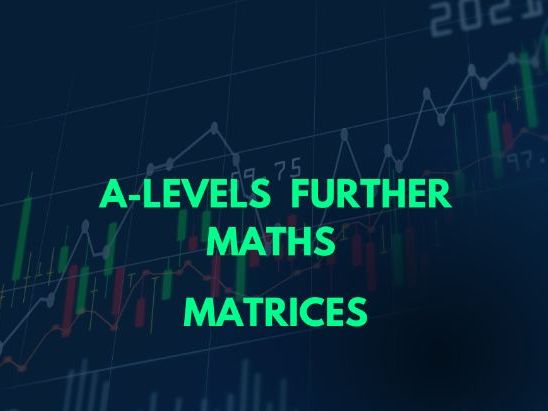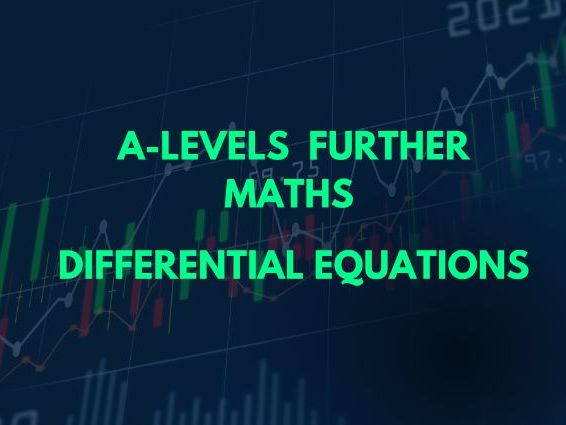91Uploads
1k+Views
76Downloads
All resources

A-Level Further Statistics - Chi-square Test PPT
Fit a theoretical distribution, as prescribed by a given hypothesis, to given data
Use a χ2-test, with the appropriate number of degrees of freedom, to carry out the corresponding goodness of fit analysis
Use a χ2-test, with the appropriate number of degrees of freedom, for independence in a contingency table.

A-Level Further Statistics - Test for Independence PPT+ Lesson Worksheet
Use a χ2-test, with the appropriate number of degrees of freedom, for independence in a contingency table.

A-Level Further Statistics – Continuous Random Variables Test PPT
Use a probability density function which may be defined piecewise
Use the general result E(g(x)) =∫f(x)g(x) dx where f(x) is the probability density function of the continuous random variable X and g(X) is a function of X
Understand and use the relationship between the probability density function (PDF) and the cumulative distribution function (CDF), and use either to evaluate probabilities or percentiles
Use cumulative distribution functions (CDFs) of related variables in simple cases e.g. given the CDF of a variable X, find the CDF of a related variable Y, and hence its PDF, e.g. where Y = X^ 3.

A-Level Further Statistics - Test for Goodness of Fit PPT+ Lesson Worksheet
Use a χ2-test, with the appropriate number of degrees of freedom, to carry out the corresponding goodness of fit analysis

A-Level Further Maths-Matrices PPT
Carry out operations of matrix addition, subtraction and multiplication, and recognise the terms zero matrix and identity (or unit) matrix
Recall the meaning of the terms ‘singular’ and ‘non-singular’ as applied to square matrices and, for 2 x 2 and 3 x 3 matrices, evaluate determinants and find inverses of non-singular matrices understand and use the result, for non-singular matrices, (AB)^ –1 = B^ –1 A^-1
The notations det M for the determinant of a matrix M, and I for the identity matrix
Understand the use of 2 x 2 matrices to represent certain geometric transformations in the x-y plane, in particular
– understand the relationship between the transformations represented by A and A^–1
– recognise that the matrix product AB represents the transformation that results from the transformation represented by B followed by the transformation represented by A
– recall how the area scale factor of a transformation is related to the determinant of the corresponding matrix
– find the matrix that represents a given transformation or sequence of transformations
Understand the meaning of ‘invariant’ as applied to points and lines in the context of transformations represented by matrices, and solve simple problems involving invariant points and invariant lines

A-Level Further Maths-Matrices Booklet + Answers
Carry out operations of matrix addition, subtraction and multiplication, and recognise the terms zero matrix and identity (or unit) matrix
Recall the meaning of the terms ‘singular’ and ‘non-singular’ as applied to square matrices and, for 2 x 2 and 3 x 3 matrices, evaluate determinants and find inverses of non-singular matrices understand and use the result, for non-singular matrices, (AB)^ –1 = B^ –1 A^-1
The notations det M for the determinant of a matrix M, and I for the identity matrix
Understand the use of 2 x 2 matrices to represent certain geometric transformations in the x-y plane, in particular
– understand the relationship between the transformations represented by A and A^–1
– recognise that the matrix product AB represents the transformation that results from the transformation represented by B followed by the transformation represented by A
– recall how the area scale factor of a transformation is related to the determinant of the corresponding matrix
– find the matrix that represents a given transformation or sequence of transformations
Understand the meaning of ‘invariant’ as applied to points and lines in the context of transformations represented by matrices, and solve simple problems involving invariant points and invariant lines

A-Level Further Pure Maths 2- Matrices Lesson Booklet + Answers
The resource covers:
Formulate a problem involving the solution of 3 linear simultaneous equations in 3 unknowns as a problem involving the solution of a matrix equation, or vice versa* Prove de Moivre’s theorem for a positive integer exponent
Understand the cases that may arise concerning the consistency or inconsistency of 3 linear simultaneous equations, relate them to the singularity or otherwise of the corresponding matrix
Solve consistent systems, and interpret geometrically in terms of lines and planes – to express trigonometrical ratios of multiple angles in terms of powers of trigonometrical ratios of the fundamental angle
Understand the terms ‘characteristic equation’, ‘eigenvalue’ and ‘eigenvector’, as applied to square matrices
Find eigenvalues and eigenvectors of 2 × 2 and 3 × 3 matrices express a square matrix in the form QDQ^–1, where D is a diagonal matrix of eigenvalues and Q is a matrix whose columns are eigenvectors, and use this expression
Use the fact that a square matrix satisfies its own characteristic equation.

A-Level Further Pure Maths 2- Matrices PPT
The resource covers:
Formulate a problem involving the solution of 3 linear simultaneous equations in 3 unknowns as a problem involving the solution of a matrix equation, or vice versa* Prove de Moivre’s theorem for a positive integer exponent
Understand the cases that may arise concerning the consistency or inconsistency of 3 linear simultaneous equations, relate them to the singularity or otherwise of the corresponding matrix
Solve consistent systems, and interpret geometrically in terms of lines and planes – to express trigonometrical ratios of multiple angles in terms of powers of trigonometrical ratios of the fundamental angle
Understand the terms ‘characteristic equation’, ‘eigenvalue’ and ‘eigenvector’, as applied to square matrices
Find eigenvalues and eigenvectors of 2 × 2 and 3 × 3 matrices express a square matrix in the form QDQ^–1, where D is a diagonal matrix of eigenvalues and Q is a matrix whose columns are eigenvectors, and use this expression
Use the fact that a square matrix satisfies its own characteristic equation.

A-Level Further Pure Maths 2- Complex Numbers Lesson Booklet + Answers
The resource covers:
Understand de Moivre’s theorem, for a positive or negative integer exponent, in terms of the geometrical effect of multiplication and division of complex numbers
Prove de Moivre’s theorem for a positive integer exponent
Use de Moivre’s theorem for a positive or negative rational exponent
– to express trigonometrical ratios of multiple angles in terms of powers of trigonometrical ratios of the fundamental angle
– to express powers of sinθand cos θ in terms of multiple angles
– in the summation of series
– in finding and using the nth roots of unity

A-Level Further Pure Maths 2- Complex Numbers PPT
The resource covers:
Understand de Moivre’s theorem, for a positive or negative integer exponent, in terms of the geometrical effect of multiplication and division of complex numbers
Prove de Moivre’s theorem for a positive integer exponent
Use de Moivre’s theorem for a positive or negative rational exponent
– to express trigonometrical ratios of multiple angles in terms of powers of trigonometrical ratios of the fundamental angle
– to express powers of sinθand cos θ in terms of multiple angles
– in the summation of series
– in finding and using the nth roots of unity

A-Level Further Pure Maths 2-Differential Equations Lesson Booklet + Answers
The resource covers:
Find an integrating factor for a first order linear differential equation, and use an integrating factor to find the general solution
Recall the meaning of the terms ‘complementary function’ and ‘particular integral’ in the context of linear differential equations, and recall that the general solution is the sum of the complementary function and a particular integral
Find the complementary function for a first or second order linear differential equation with constant coefficients
Recall the form of, and find, a particular integral for a first or second order linear differential equation in the cases where a polynomial or ae^bx or a cos px + b sin px is a suitable form, and in other simple cases find the appropriate coefficient(s) given a suitable form of particular integral.
Use a given substitution to reduce a differential equation to a first or second order linear equation with constant coefficients or to a first order equation with separable variables.
Use initial conditions to find a particular solution to a differential equation, and interpret a solution in terms of a problem modelled by a differential equation

A-Level Further Pure Maths 2-Differential Equations PPT
The resource covers:
Find an integrating factor for a first order linear differential equation, and use an integrating factor to find the general solution
Recall the meaning of the terms ‘complementary function’ and ‘particular integral’ in the context of linear differential equations, and recall that the general solution is the sum of the complementary function and a particular integral
Find the complementary function for a first or second order linear differential equation with constant coefficients
Recall the form of, and find, a particular integral for a first or second order linear differential equation in the cases where a polynomial or ae^bx or a cos px + b sin px is a suitable form, and in other simple cases find the appropriate coefficient(s) given a suitable form of particular integral.
Use a given substitution to reduce a differential equation to a first or second order linear equation with constant coefficients or to a first order equation with separable variables.
Use initial conditions to find a particular solution to a differential equation, and interpret a solution in terms of a problem modelled by a differential equation

A-Level Further Pure Maths 2-Integration Lesson Booklet + Answers
The resource covers:
Integration hyperbolic functions and inverses
Derive and use reduction formulae for the evaluation of definite integrals
Approximating area under a curve using area of rectangles and use rectangles to estimate or set bounds for the area under a curve or to derive inequalities or limits concerning sums
Use integration to find arc lengths for curves with equations in Cartesian coordinates, including the use of a parameter, or in polar coordinates
Use integration to find surface areas of revolution about one of the axes for curves with equations in Cartesian coordinates, including the use of a parameter.

A-Level Further Pure Maths 2-Differentiation Lesson Booklet+ Answers
The resource covers :
Differentiating hyperbolic functions and inverses
Differentiation implicit functions
Differentiating parametric equations
Differentiating inverse of trigonometric functions
Maclaurin series

A-Level Further Maths-Rational Functions and Graphs PPT
Sketch graphs of simple rational functions, including the determination of oblique asymptotes, in cases where the degree of the numerator and the denominator are at most 2
Show significant features of rational graphs, such as turning points, asymptotes and intersections with the axes.
Determination of the set of values taken by the function, e.g. by the use of a discriminant.
Understand and use relationships between the graphs of y = f(x), y^2 = f(x), y = 1/f(x) , y = If(x)I and y = f(IxI)

A-Level Further Maths-Polar Coordinates PPT
Understand the relations between Cartesian and polar coordinates, and convert equations of curves from Cartesian to polar form and vice versa
Sketch simple polar curves, for 0≤θ<2π or -π≤θ<π or a subset of either of these interval
Recall the formula 1/2 ∫r^2 dθ for the area of a sector and use this formula in simple cases.

A-Level Further Maths-Vectors PPT
Use the equation of a plane in any of the forms ax + by + cz = d or r.n = p
or r = a + λb + μc and convert equations of planes from one form to another as necessary in solving problems
Recall that the vector product a × b of two vectors can be expressed either as absinθn ̂ ,
where n ̂ is a unit vector, or in component form ai+bj+ck
Use equations of lines and planes, together with scalar and vector products where appropriate, to solve problems concerning distances, angles and intersections, including
– determining whether a line lies in a plane, is parallel to a plane or intersects a plane, and finding the point of intersection of a line and a plane when it exists
– finding the foot of the perpendicular from a point to a plane
– finding the angle between a line and a plane, and the angle between two planes
– finding an equation for the line of intersection of two planes
– calculating the shortest distance between two skew lines
– finding an equation for the common perpendicular to two skew lines.

A-Level Further Maths-Polar Coordinates Booklet + Answers
Understand the relations between Cartesian and polar coordinates, and convert equations of curves from Cartesian to polar form and vice versa
Sketch simple polar curves, for 0≤θ<2π or -π≤θ<π or a subset of either of these interval
Recall the formula 1/2 ∫r^2 dθ for the area of a sector and use this formula in simple cases.

A-Level Further Maths-Vectors Booklet + Answers
Use the equation of a plane in any of the forms ax + by + cz = d or r.n = p
or r = a + λb + μc and convert equations of planes from one form to another as necessary in solving problems
Recall that the vector product a × b of two vectors can be expressed either as absinθn ̂ ,where n ̂ is a unit vector, or in component form ai+bj+ck
Use equations of lines and planes, together with scalar and vector products where appropriate, to solve problems concerning distances, angles and intersections, including
– determining whether a line lies in a plane, is parallel to a plane or intersects a plane, and finding the point of intersection of a line and a plane when it exists
– finding the foot of the perpendicular from a point to a plane
– finding the angle between a line and a plane, and the angle between two planes
– finding an equation for the line of intersection of two planes
– calculating the shortest distance between two skew lines
– finding an equation for the common perpendicular to two skew lines.

A-Level Further Maths-Proof by Induction PPT
Empower your students and elevate your lessons with our expertly designed PPT for teaching proof by induction. Cover these critical concepts with confidence:
Summation of Series
General Terms in Sequences
Divisibility Rules
Matrix Products
Complex Numbers
Reduction Formulae
Finding the 𝑛𝑡ℎ Derivative




















